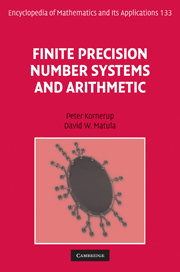1 - Radix polynomial representation
Published online by Cambridge University Press: 05 March 2013
Summary
Introduction
From the earliest cultures humans have used methods of recording numbers (integers), by notches in wooden sticks or collecting pebbles in piles or rows. Conventions for replacing a larger group or pile, e.g., five, ten, or twelve objects, by another object or marking, are also found in some early cultures. Number representations like these are examples of positional number systems, in which objects have different weight according to their relative positions in the number. The weights associated with different positions need not be related by a constant ratio between the weights of neighboring positions. In time, distance, old currency, and other measuring systems we find varying ratios between the different units of the same system, e.g., for time 60 minutes to the hour, 24 hours to the day, and 7 days to the week, etc.
Systems with a constant ratio between the position weights are called radix systems; each position has a weight which is a power of the radix. Such systems can be traced back to the Babylonians who used radix 60 for astronomical calculations, however without a specific notation for positioning of the unit, so it can be considered a kind of floating-point notation. Manipulating numbers in such a notation is fairly convenient for multiplication and division, as is known for anyone who has used a slide rule. Our decimal notation with its fixed radix point seems to have been developed in India about 600 CE, but without decimal fractions.
- Type
- Chapter
- Information
- Finite Precision Number Systems and Arithmetic , pp. 1 - 58Publisher: Cambridge University PressPrint publication year: 2010

